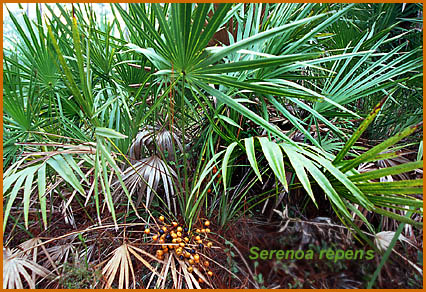Saw Palmetto
Serenoa repens
Family: Arecaceae

Saw palmetto leaves and fruit
Photo credit: SFRC, University of Florida
Natural History
Saw palmetto gets its common name from the two rows of teeth that appear along the petiole of each leaf. The teeth are tiny but very sharp, and they can cut just like the blade of a saw when something is pulled across them. If you make the mistake of walking through a field of palmetto in shorts, you'll likely end up with a number of long, thin cuts along your legs.
Saw palmetto grows on a wide variety of sites, from dry and open to seasonally wet and semi-shady. Across this wide range of habitats, it most frequently occurs on sand ridges, flatwood forests, coastal dunes, and islands near marshes. Saw palmetto is the dominant ground cover in some southeastern pine forests, sometimes covering hundreds of acres. Saw palmetto often grows in clumps 20' or more in diameter.
Saw palmetto is found in most of the southeast coastal plain, between Louisiana and Florida in the south, to South Carolina in the north.
Black bears, white-tailed deer, and feral hogs eat the fruits of saw palmetto. Native Americans also used the fruits for food. The fruits are collected today for herbal medicines that may help prevent certain forms of cancer. The flowers are an important source of honey and clumps of palmetto are often favorite hiding places of rattlesnakes, wasps, and the Florida panther.
Saw palmetto may be confused with dwarf palmetto (Sabal minor) because of their similar sizes and leaf shapes. Dwarf palmetto has blue-green leaves, has no spines on the leaf stems, and the circular fruits are about ½" in diameter.
